Top 12 Fabricator Skills to Put on Your Resume
In a crowded hiring landscape, fabricators who blend sharp hands-on ability with clear thinking win the day. Showcasing the right mix of technical mastery and soft skills on your resume does more than tick boxes—it signals you can deliver tight tolerances, safe practices, and repeatable results when the metal gets hot and the clock runs fast.
Fabricator Skills
- MIG Welding
- TIG Welding
- CNC Machining
- Plasma Cutting
- AutoCAD
- SolidWorks
- Blueprint Reading
- Metal Fabrication
- Precision Measuring
- Laser Cutting
- Sheet Metal Work
- Soldering
1. MIG Welding
MIG welding uses a continuously fed wire and shielding gas to create strong, efficient joints. The arc melts the wire into the weld pool while you control travel, angle, and stick-out to keep the bead smooth and sound.
Why It's Important
It’s fast, forgiving, and versatile across steels, stainless, and aluminum (with the right setup). That means higher throughput, cleaner results, and less post-weld rework—bread and butter for production.
How to Improve MIG Welding Skills
Prep ruthlessly: Clean to bright metal, bevel when needed, and fit parts tight. Contaminants and gaps chew up quality.
Dial in settings: Match voltage and wire feed to thickness. Keep stick-out in the 3/8–1/2 in range for mild steel, adjust inductance if available.
Steady technique: 10–15° push angle for most mild steel, consistent travel speed, short arc. Weave only when the joint demands it.
Match wire and gas: ER70S-6 with C25 for mild steel, tri-mix or 98/2 for stainless, 100% argon and a spool gun or push-pull for aluminum.
Train all positions: Practice flat, horizontal, vertical up, overhead. Real jobs won’t be perfectly placed.
Maintain gear: Change contact tips, clean liners, set correct drive roll tension, clamp a clean ground close to the joint.
Protect yourself: Proper PPE, fume extraction, cylinder safety, clear work area.
Small refinements stack up—your welds will show it.
How to Display MIG Welding Skills on Your Resume
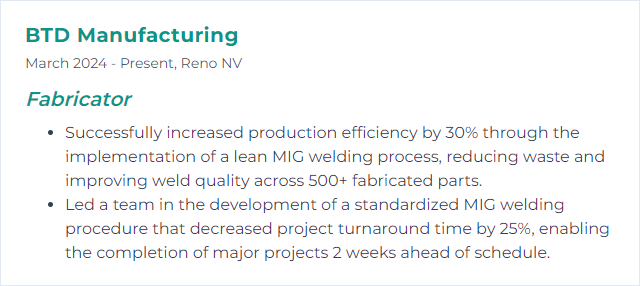
2. TIG Welding
TIG (GTAW) welding uses a non-consumable tungsten electrode and an inert shielding gas for precise, clean welds. You control heat with a foot pedal or fingertip control, then add filler only as needed.
Why It's Important
When the job demands finesse—thin wall tubing, intricate joints, exotic alloys—TIG delivers pristine beads and tight control over heat input and distortion.
How to Improve TIG Welding Skills
Cleanliness rules: Degrease, use dedicated stainless brushes, and keep everything spotless.
Tungsten matters: 2% lanthanated or similar, sharpened to a long taper for DC. For aluminum on AC, use a pointed or slightly rounded tip; set AC balance and frequency to manage cleaning and penetration.
Right settings: DCEN for steel and stainless. AC for aluminum with adequate post-flow and a gas lens for smoother shielding.
Match filler: Choose filler to base metal and thickness. Keep diameter appropriate so it wets quickly without chilling the puddle.
Arc control: Hold arc length near the tungsten diameter, move with a steady rhythm, dab filler at the leading edge.
Fit-up and tacks: Tight gaps, strong tacks, heat sink where needed to tame distortion.
Safety: Eye protection, gloves, ventilation. AC glare is no joke.
Precision grows with repetition and calm hands.
How to Display TIG Welding Skills on Your Resume

3. CNC Machining
CNC machining translates digital designs into parts by controlling tools with code. Mills, lathes, routers—programmed moves carve raw stock into precise geometry.
Why It's Important
It brings repeatability, tight tolerances, and speed, reducing scrap and manual touch time while unlocking complex shapes that hand tools simply can’t match.
How to Improve CNC Machining Skills
Pick the right tool: Geometry, coating, and substrate should suit material and operation. Keep runout low and tools sharp.
Nail the numbers: Base speeds on surface feet per minute and chip load per tooth. Validate with test coupons and adjust for chatter, heat, or poor chips.
Rock-solid workholding: Rigid fixtures, minimal stick-out, proper torque on vises and clamps.
Coolant strategy: Flood, mist, or MQL—choose what the material needs. Maintain mix, aim, and cleanliness.
Efficient toolpaths: Favor climb milling, adaptive/trochoidal strategies, rest machining, and sensible retracts. Reduce air cutting.
Probe and verify: Set work offsets with probing, run first-article checks, and monitor critical features during long runs.
Care for the machine: Warm-up cycles, lubrication, backlash checks, ball screw and way inspections.
Track data: Tool life, cycle time, scrap—measure and tweak for steady gains.
Smart programming paired with sturdy setups makes parts sing.
How to Display CNC Machining Skills on Your Resume
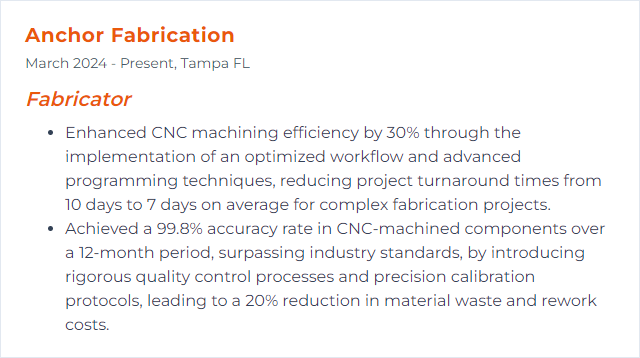
4. Plasma Cutting
Plasma cutting blasts an ionized gas jet through conductive metal, slicing quickly and cleanly when set up correctly. Great for plate work, brackets, and rapid layout changes.
Why It's Important
Speed, versatility, and low operating cost make it a go-to for many fabrication shops handling mild steel, stainless, and aluminum.
How to Improve Plasma Cutting Skills
Right consumables: Match nozzle, electrode, and shield to material and amperage; swap at the first hint of wear.
Correct standoff: Maintain torch-to-work distance—often near 1/16–1/8 in—with consistent height control.
Optimize pierce and speed: Use proper pierce height/time and travel speed. Drag lines should angle slightly; vertical lines usually mean too slow.
Dry, clean air: Use a dryer and filters. Moisture kills cut quality and consumables.
Ground and table setup: Good work return, flat slats, minimal vibration. Keep slag cleared.
Routine checks: Inspect torch leads, connections, and air pressure regularly.
CNC for repeatability: For complex or repeat parts, CNC control locks in accuracy and throughput.
Consistency here saves money downstream—on fit-up and finish work.
How to Display Plasma Cutting Skills on Your Resume
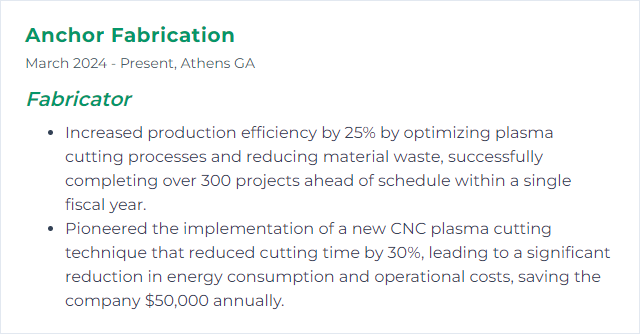
5. AutoCAD
AutoCAD is a CAD platform for drafting and detailing 2D and 3D designs, turning concepts into clear drawings that guide fabrication with confidence.
Why It's Important
Accurate drawings prevent costly mistakes on the shop floor. Clear dimensions, layers, and callouts reduce ambiguity and speed production.
How to Improve AutoCAD Skills
Start with templates: Standard layers, linetypes, title blocks, and plot styles pre-baked into company templates.
Tool palettes and blocks: Dynamic blocks and custom palettes put your most-used items a click away.
Use Xrefs: Keep files lean and coordinated by referencing large elements instead of copying them.
Parametric constraints: Lock down relationships so edits don’t break geometry or spacing.
Annotative discipline: Dimensions and text that scale correctly cut rework to zero.
Automation: LISP, scripts, and macros to crush repetitive tasks.
Performance hygiene: PURGE, AUDIT, and OVERKILL regularly; keep drivers current and use SSD storage.
Standards control: Enforce CAD standards so multiple drafters produce consistent, fabricator-friendly drawings.
Less click-drag, more precision. That’s the game.
How to Display AutoCAD Skills on Your Resume

6. SolidWorks
SolidWorks is a 3D CAD system for building parts, assemblies, and drawings that reflect real-world manufacturing constraints.
Why It's Important
You can model once, then drive flat patterns, cut lists, and CNC data from the same source. That reduces handoffs, mistakes, and scrap.
How to Improve SolidWorks Skills
Own Sheet Metal: K-factors, bend tables, reliefs, and accurate flats that match the brake.
Leverage Weldments: Structural members with cut lists, miters, and gussets straight from sketches.
Configurations: Variants controlled by design tables keep families of parts tidy.
Top-down design: Skeleton sketches, reference geometry, and stable mates for robust assemblies.
Real materials: Custom materials with accurate density and mechanical data for weight and simulation checks.
Drafting discipline: Model Items, GD&T, and drawing templates that mirror shop expectations.
Integrated CAM: Move from model to toolpath without rework or translation mess.
File control: Manage references and revisions so updates flow without breaking links.
Design with the bend, bead, and cutter in mind from the start.
How to Display SolidWorks Skills on Your Resume
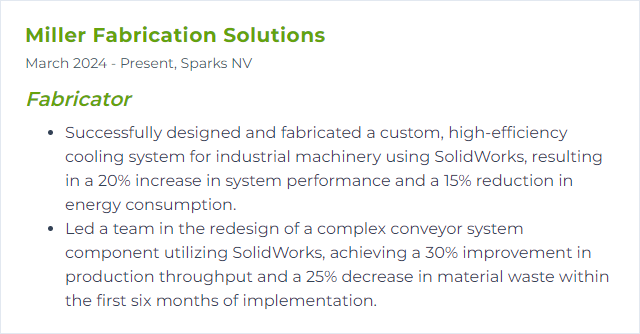
7. Blueprint Reading
Blueprint reading means decoding drawings—views, symbols, notes, and tolerances—so you can build exactly what’s intended without guesswork.
Why It's Important
It aligns the shop with the design. You avoid miscuts, cracked welds, and frantic rework by understanding the print before the first spark.
How to Improve Blueprint Reading Skills
Master symbols: Line types, weld symbols, surface finishes, and notes—know them cold.
Use every view: Orthographic, section, detail, and auxiliary views reveal hidden geometry.
Dimensions and GD&T: Datums, position, profile, MMC/LMC. Understand function, not just numbers.
Scales and units: Watch conversions and ensure tools match the drawing’s scale.
Revisions matter: Check title blocks and change notes; work to the latest version only.
Practice: Mark up prints, trace process steps, and verify with sample measurements.
Clarity on paper equals precision in metal.
How to Display Blueprint Reading Skills on Your Resume

8. Metal Fabrication
Metal fabrication turns raw stock into finished parts by cutting, forming, joining, and finishing to specification.
Why It's Important
From brackets to frames to enclosures, nearly every industry leans on fabricated metal. Quality fabrication multiplies reliability up and down the supply chain.
How to Improve Metal Fabrication Skills
Choose the right path: Map process flow—cut, form, weld, finish—based on material, tolerance, and volume.
Fixture smart: Jigs and locating features speed repeat jobs and improve consistency.
Lean habits: 5S, standard work, and visual cues reduce motion, waiting, and scrap.
Quality gates: First-article checks, control plans, and SPC on critical dims.
Welding procedures: Document and qualify WPS/PQR, and keep welders current on procedure ranges.
Safety first: Hazard assessments, fume extraction, guarding, and lockout/tagout.
Sustainability: Tight nesting, scrap segregation, energy-wise fume filtration, and consumable tracking.
Upskill regularly: New alloys, machines, and techniques keep arriving—stay current.
Tuned processes produce unbeatable repeatability.
How to Display Metal Fabrication Skills on Your Resume
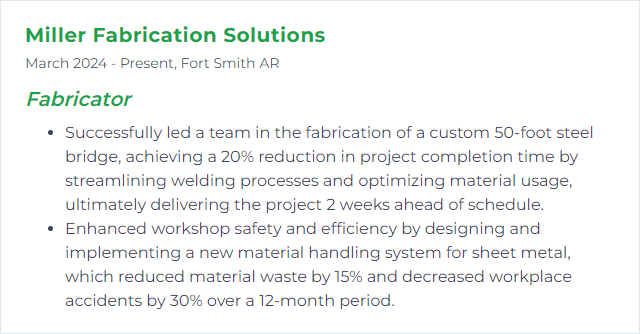
9. Precision Measuring
Precision measuring uses calibrated tools to verify parts meet exact dimensions and tolerances, from simple calipers to CMMs and gauges.
Why It's Important
Fit, function, and safety depend on size and geometry. Accurate measurement prevents hidden failures and costly rework.
How to Improve Precision Measuring Skills
Right tool for the job: Calipers for quick checks, micrometers for tight tolerance features, height gauges, bore gauges, pins, and CMMs when needed.
Calibrate and verify: Scheduled calibration, daily checks with gauge blocks, and gauge R&R to confirm consistency.
Control the environment: Temperature stability near 20°C, allow parts to cool before measuring, and avoid drafts or direct heat.
Technique matters: Consistent pressure, proper alignment to avoid cosine error, zero tools before use.
Document results: Traceable records, control plans, and clear pass/fail criteria.
Capture data digitally: SPC dashboards and connected tools spot trends before parts drift.
Measure twice, then prove it with data.
How to Display Precision Measuring Skills on Your Resume
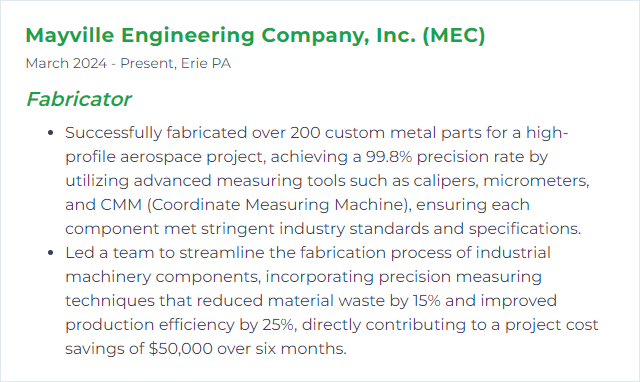
10. Laser Cutting
Laser cutting focuses high-energy light onto material to slice precise profiles with minimal burr and narrow kerf.
Why It's Important
It delivers sharp edges, tight detail, and swift turnaround across thin to moderately thick sheet, often with little post-processing.
How to Improve Laser Cutting Skills
Focus and alignment: Set focal position and check nozzle alignment; poor focus equals rough edges.
Assist gas choices: Oxygen for speed on steel, nitrogen for oxide-free edges, clean dry air for economy—keep purity high and pressures correct.
Kerf and lead-ins: Apply proper kerf compensation, lead-ins/outs, tabs, and microjoints to stabilize small features.
Nesting strategy: Common-line cutting, tight nesting, and heat management patterns save stock and keep parts flat.
Maintenance rhythm: Clean lenses and mirrors, check bellows and filters, maintain the chiller, and keep optics pristine.
Parameter tuning: Balance power, speed, frequency/duty cycle for each thickness and alloy.
Edge quality checks: Diagnose dross, striations, and taper; adjust gas, focus, or speed accordingly.
Safety and fume control: Enclosures, interlocks, and robust extraction protect people and optics.
Get the light right, and everything else falls in line.
How to Display Laser Cutting Skills on Your Resume

11. Sheet Metal Work
Sheet metal work turns flat stock into formed parts through cutting, bending, fastening, and finishing.
Why It's Important
Enclosures, ducts, brackets, guards, and frames—sheet metal is everywhere, and good form work leads to quick assembly and tidy fit.
How to Improve Sheet Metal Work Skills
Know your math: Bend allowances, deductions, and K-factors that actually match your tooling and material.
Tooling choice: V-die openings, punch radii, and air bending vs bottoming all change outcomes and springback.
Respect grain direction: Bends across grain reduce cracking on tight radii.
Hardware and joints: PEMs, rivets, spot welds—use correct hole sizes and spacing for strength and appearance.
Design rules: Maintain hole-to-bend distance, avoid tiny features near bends, and add reliefs where needed.
Finish prep: Deburr, radius sharp edges, and clean thoroughly for coating or plating.
Protect surfaces: Films, soft jaws, and nylon tools keep cosmetic faces clean.
Maintain machines: Press brakes and shears demand regular checks to hold angle and cut quality.
The flat pattern tells a story—make sure the press brake reads it the same way.
How to Display Sheet Metal Work Skills on Your Resume

12. Soldering
Soldering joins metal parts by melting a filler that wets the joint and solidifies into a reliable electrical and mechanical bond.
Why It's Important
From electronics to small assemblies, soldering delivers low-heat, precise joins that won’t distort delicate components.
How to Improve Soldering Skills
Control the heat: Use a temperature-controlled iron with the right tip size and shape for the job.
Care for the tip: Keep it clean and tinned; oxidation ruins wetting and makes joints dull and weak.
Pick the right solder and flux: Lead-free alloys (like SAC305) for compliance, rosin or no-clean flux as needed; clean residues when reliability matters.
Joint design: Aim for capillary action with proper clearances and solid mechanical support before solder flows.
Timing and dwell: Heat the joint, not the solder; apply just enough time to wet fully without cooking components.
ESD awareness: Protect sensitive electronics with grounding and proper handling.
Inspect relentlessly: Smooth, shiny fillets, no voids or spikes; use magnification and, for hidden joints, destructive tests or x-ray if required.
Practice: Repetition builds muscle memory and clean technique.
Neat joints are faster than rework—skill shows in every fillet.
How to Display Soldering Skills on Your Resume

